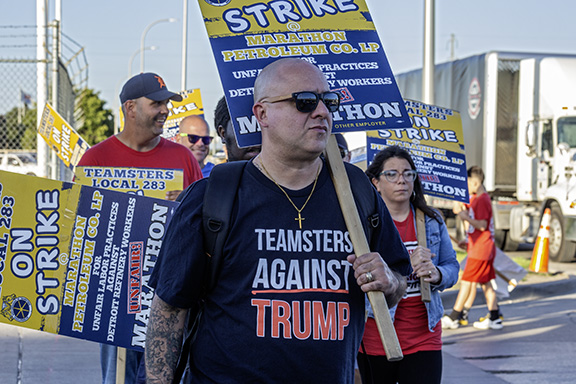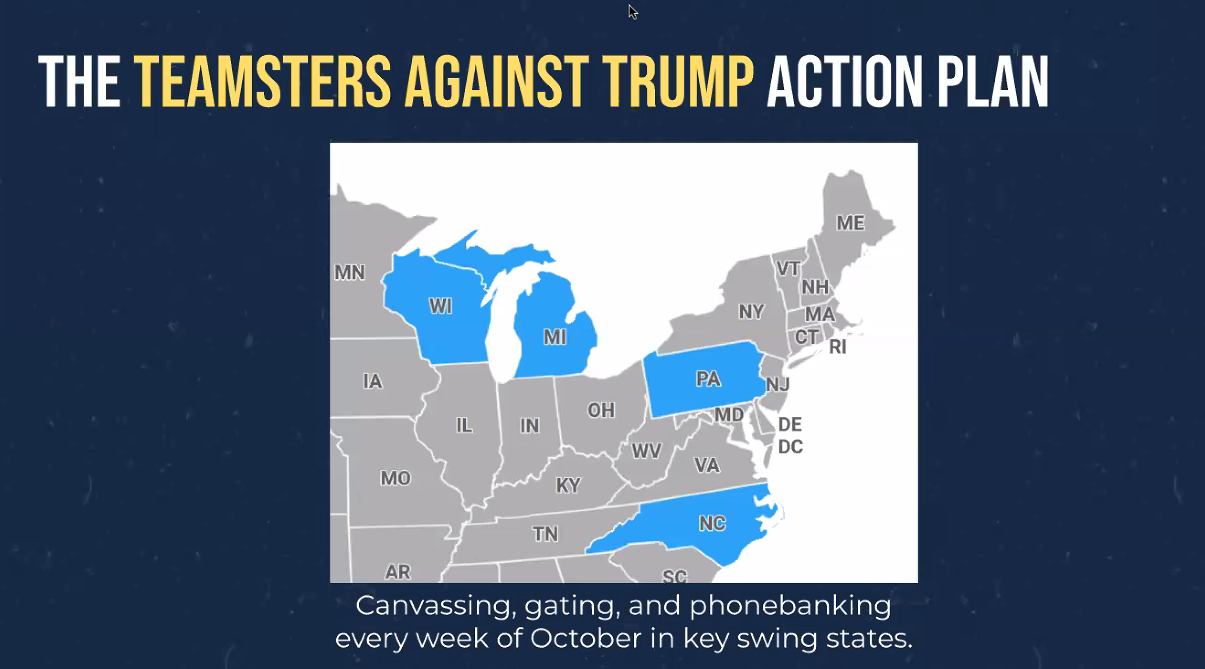Steve Early
Posted May 21, 2025

The following discussion is part of a longer analysis published in Social Policy (Spring 2025), “From L4B to TAT. Challenging Union Political Endorsements Takes Rank-&-File Action,” which includes an account of the Labor for Bernie initiatives in the 2016 and 2020 presidential election campaigns. Steve Early worked for nearly 30 years as an International Union representative for the Communication Workers of America and helped co-found Labor for Bernie. In the late 1970s, he worked for the Professional Drivers Council (PROD), which became part of Teamsters for a Democratic Union. He is the author of Save Our Unions and other books about labor, politics, or veterans affairs. He can be reached at lsupport@aol.com.
THE ORGANIZATIONAL MODEL of labor activists forming an ad hoc group to rally fellow workers against the threat of Donald Trump was re-fashioned last year in the International Brotherhood of Teamsters (IBT), when its top leadership failed to endorse anyone for president in 2024.
Although not an AFL-CIO affiliate, the IBT used the federation’s own recommended method for involving union members in headquarters decisions about candidate endorsements. These steps included making the results of Teamster “town hall meetings” and later membership polling unusually transparent.
In the union’s first round of that opinion sampling and shaping, in the spring of 2024, about 12,000 Teamsters (out of more than a million eligible) went to their local union halls and filled out cards indicating their preferred candidate.
As one long-time member of Teamsters for a Democratic Union (TDU) from Michigan reports, this stage of the process “favored union activists” because “pro-Trump, Republican leaning members were not the majority at these gatherings.” There was also an opportunity for face-to-face debate and discussion before any non-binding paper ballots were cast. As a result, then-President Joe Biden emerged as the favorite over Trump by a 44 to 36 percent margin.
When an outside contractor hired by the IBT conducted an on-line poll after Biden’s subsequent withdrawal from the race, Teamsters had another opportunity to rally fellow members on behalf of their preferred candidate.
Trump supporters used several online networks for their GOTV efforts, while no equivalent network existed for Biden’s replacement, Vice-President Kamala Harris. Backers of the new Democratic candidate were not yet well organized or funded.
So this time, Trump was backed by 59 percent of the 35,000 Teamsters participating, while only 34% favored Harris. An overlapping phone survey of 900 Teamsters, conducted by Lake Research Partners, in early September, 2024, revealed the same level of support for Trump (58%), but even less for Harris (31%).
Street Cred of New Leaders Not Deployed

Based on the positive results of the IBT’s UPS contract campaign in 2023, some TDU leaders initially hoped that new Teamster President Sean O’Brien and Secretary-Treasurer Fred Zuckerman would use their credibility among 350,000 UPS workers to help rally the Teamster rank-and-file against Trump in 2024. This would have been particularly helpful in blue collar battleground states like Pennsylvania, Michigan, and Wisconsin.
However, in the absence of any mandate from the IBT membership — and O’Brien’s personal decision to play footsie with Trump — no such national union push was ever undertaken on Harris’s behalf.
When the Republican National Convention met in Milwaukee last July, O’Brien wangled a high-profile speaking slot for himself (which the Democratic Party declined to give him). In front of a slack-jawed conservative crowd, a “labor boss” of the sort not usually welcome in GOP circles denounced union busting by corporate America.
But O’Brien also made the factually challenged claim that faux populists like Senators J.D. Vance, Josh Hawley, and Markwayne Mullin — and even his convention host, Donald Trump — could be helpful legislative allies on some labor issues. And he tried to turn this convention speech into a declaration of independence from a corporate-dominated Democratic Party, which had often betrayed Teamsters and other union members, in the past, on issues like free trade.
More politically savvy Teamsters were angered and disappointed by O’Brien’s failure to challenge the GOP’s own anti-union agenda, which (as implemented since January 20 of this year) has been a non-stop disaster. Rather than taking any new political path, O’Brien was merely aping his own benighted IBT predecessors who befriended Republicans like Richard Nixon, Gerald Ford, Ronald Reagan, and George H.W. Bush, while the rest of organized labor was trying to defeat them in the 1960s, ’70s, or ’80s.
Last Sept. 18, a majority of the IBT executive board — in similar old guard fashion — decided that Teamster headquarters should remain neutral in the 2024 presidential race. This controversial decision immediately put a hastily assembled network called Teamsters Against Trump (TAT) into overdrive.
Formed in August, TAT was funded by concerned individuals and progressive organizations — outside the Teamsters — who quickly raised a war-chest of more than $500,000. A full-time national organizer was hired for three months, who helped coordinate the grassroots work of rank-and-file volunteers and more than 50 local union stewards working on a “lost-time” (ie paid) basis.
IBT Local Affiliates Did Take a Stand
TAT sometimes had the benefit of operating on friendly turf — as in IBT locals, caucuses, or joint councils — representing nearly a million members — who declared their support for Harris, despite the no-endorsement stance of the union’s top leadership in Washington.
In other parts of the country, “the sad reality is that many Teamsters and other union members bought Trump’s populist persona and rhetoric,” said TAT supporter Dan Campbell. “So it was our job to engage them.” TAT phone-bankers, leaflet distributors, and texters like Campbell focused on fellow Teamsters in several key Rust Belt states—Pennsylvania, Michigan, and Wisconsin, as well as North Carolina and Arizona. Some TAT activists joined state AFL-CIO canvassing efforts that, in four of those states, helped Democrats win Senate races against Trump supporters, even while Trump beat Harris there.
For Campbell, a retired UPS driver in Wisconsin and longtime TDU steering committee member, one key motivating issue was very personal. In 2021, he says, the Biden Administration won passage to the Butch Lewis Emergency Pension Plan Relief Act, which “saved my pension and the retirement security of 400,000 other Teamsters across the Midwest and South. Every single Republican Senator opposed this, but Harris, as vice-president showed up to cast the tie-breaking vote for it, in the Senate.”
TAT campaigners also warned Teamster voters that any undermining of private sector labor law enforcement by Trump would make their own union’s organizing at Amazon and other big companies much harder. That prediction has certainly come true. Nevertheless, in a podcast interview with Tucker Carlson after the 2024 election, O’Brien still confidently asserted that he was “going to put Amazon on its knees” — as if Amazon could be defeated via a personal arm wrestling match with billionaire Jeff Bezos, Amazon’s owner who attended Trump’s inauguration along with O’Brien.
Teamsters Against Trump was a necessary, last-minute attempt to address the failings and shortcomings of IBT membership education and mobilization about politics. If that’s not done systematically, year in and year out, labor bureaucrats have good reason to worry about getting problematic results when, every four years, they conduct internal surveys about membership opinion on presidential candidates.
Most of these national union polling results are never released, unlike in the IBT last year. Yet top union officials then proceed to back the political candidate of their choice in a fashion that often just reinforces membership cynicism about and future disengagement from the process. Only rarely is such an important national union decision made by a binding membership vote.
Last year’s lower-down rifts in the Teamster officialdom—on the question of Trump vs. Harris—did create 9th inning opportunities for rank-and-file campaigning by TAT supporters But, in the future, it would be far preferable to have national leaders willing to spend union treasury funds on a year-round political action program that helps working members better distinguish between their real enemies and their lesser-evil “friends,” while also developing more credible labor-based alternatives to candidates fielded by both major parties.





Leave a Reply